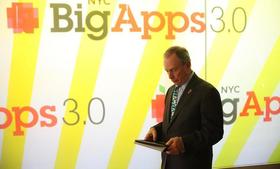Mayor Michael Bloomberg last summer announced a suite of initiatives to expand New York City’s broadband connectivity.
Aimed at bolstering the tech sector and providing businesses and residents with high-speed Internet services, the initiatives were an admirable step forward.
Big Apple residents, however, soon realized that with regard to high-speed Internet, New York City has a long and expensive way to go.
 Broadband is a general term for high-speed Internet, which can be garnered through multiple transmission technologies including DSL, fiber, wireless, cable modem and satellite. While these transmitters all technically fall within the broadband umbrella, not all forms of transmission are created equal.
Broadband is a general term for high-speed Internet, which can be garnered through multiple transmission technologies including DSL, fiber, wireless, cable modem and satellite. While these transmitters all technically fall within the broadband umbrella, not all forms of transmission are created equal.
DSL transmits information at speeds of up to 6 Mbps, while fiber can reach 25 times that, with speeds of 150 Mbps. In fact, in 2011, Google announced the launching of Google Fiber in Kansas City, which promises speeds of one gigabit per second—if you can handle living in Kansas City. To put this speed in perspective, users of this technology can download an HD movie in less than three seconds.
New York City aims to be the epicenter of the tech world, but analysts claim that without the proper infrastructure or technology, it will be difficult to grab that title. Recently, New America Foundation ranked cities worldwide based on their fastest advertised Internet speeds. With current download speeds of 150 Mbps, New York City ranked a barely respectable 10thplace worldwide.
The city is home to a large array of venture capitalists and investors, which puts New York City in a unique position to attract startups. Although funding and capital are the keys to a company’s viability, high and consistent levels of broadband speeds are vital for attracting startups.
Now, a year later, Bloomberg’s directive is due for an evaluation:
WiredNYC: Broadband Proliferation Partners LLC was selected by the city and has been working to create a building certification program that ranks the existing connectivity and infrastructure of commercial properties using a uniform standard. This large-scale project will serve as a database for prospective tenants in their search for viable work space. The project aims to certify 500 commercial buildings in the next two years.
ConnectNYC: Tenants seeking fiber broadband connectivity were invited to submit proposals detailing the potential impact fiber could have on their developing businesses. Twenty-four winners, who demonstrated that their landlords would acquiesce and that their business productivity would substantially improve, were chosen to receive the fiber build-out at no cost. (See them here.) The average cost of a fiber build-out is $50,000 per business. According to the program’s mandate, New York City will spend $12 million over a two-year period to provide this service.
The program elicited numerous responses from contestants, suggesting serious interest, but it also brought home an undeniable fact: fiber installation is expensive. If small projects require millions of dollars, the ultimate goal will require billions.
Micro-Trenching Pilot: This initiative involves cutting shallow grooves in the ground for fiber laying, which would streamline the current onerous process. Current installation procedures require deep trenches for laying cable, a labor-intensive and expensive process that requires streets to be closed or disrupted for weeks.
Utilizing this newer initiative would speed the deployment of fiber installation throughout the five boroughs. Announced in April, this program is still in its infancy. Verizon is currently testing the technology at 12 sites across the five boroughs at no cost to taxpayers. If it is successful, it could transform fiber installation. However, concerns that shallow lines will be subject to breakage and weather disruptions are still being evaluated.



